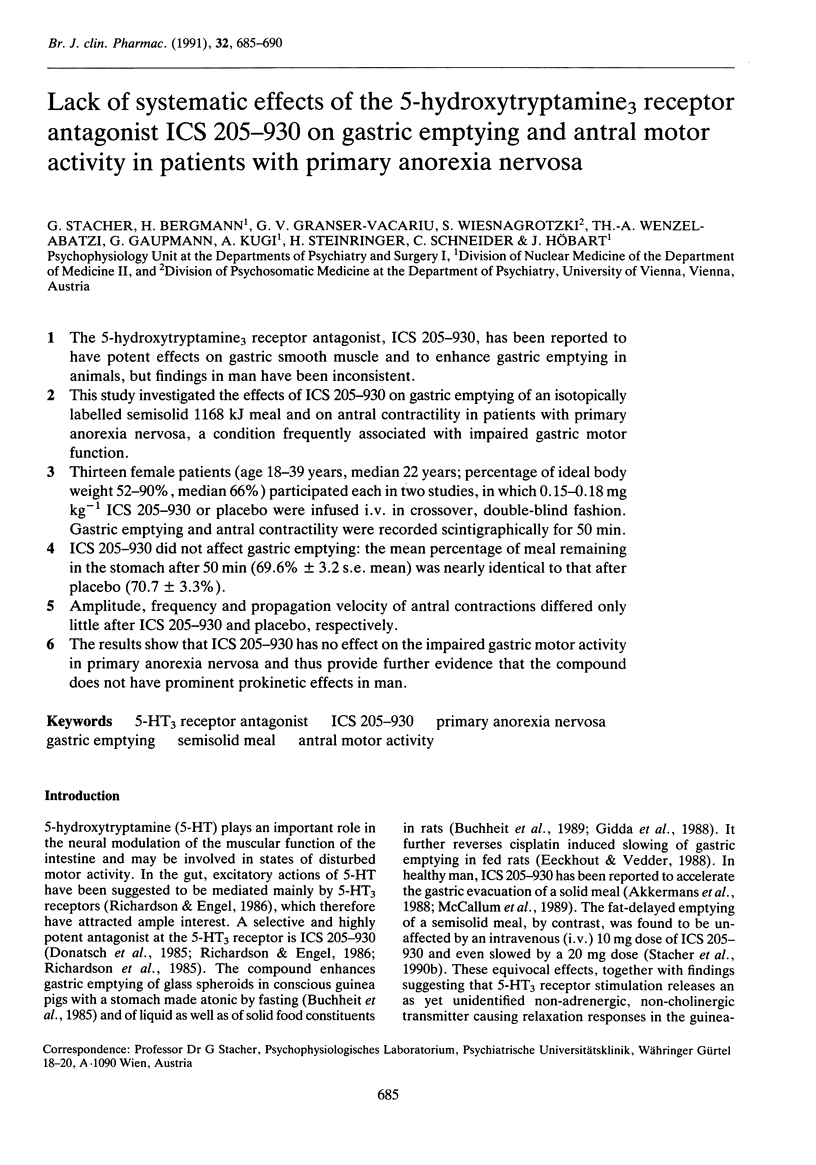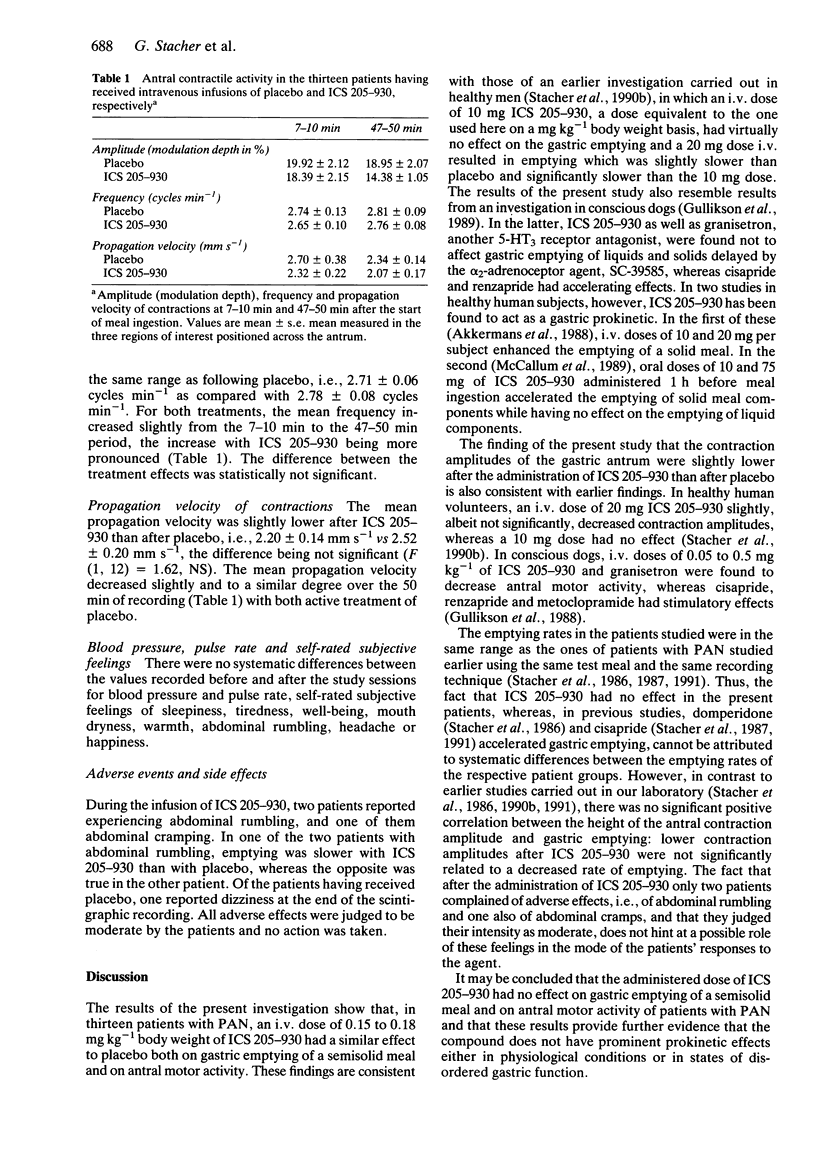Abstract
1. The 5-hydroxytryptamine 3 receptor antagonist, ICS 205-930, has been reported to have potent effects on gastric smooth muscle and to enhance gastric emptying in animals, but findings in man have been inconsistent. 2. This study investigated the effects of ICS 205-930 on gastric emptying of an isotopically labelled semisolid 1168 kJ meal and on antral contractility in patients with primary anorexia nervosa, a condition frequently associated with impaired gastric motor function. 3. Thirteen female patients (age 18-39 years, median 22 years; percentage of ideal body weight 52-90%, median 66%) participated each in two studies, in which 0.15-0.18 mg kg-1 ICS 205-930 or placebo were infused i.v. in crossover, double-blind fashion. Gastric emptying and antral contractility were recorded scintigraphically for 50 min. 4. ICS 205-930 did not affect gastric emptying: the mean percentage of meal remaining in the stomach after 50 min (69.6% +/- 3.2 s.e. mean) was nearly identical to that after placebo (70.7 +/- 3.3%). 5. Amplitude, frequency and propagation velocity of antral contractions differed only little after ICS 205-930 and placebo, respectively. 6. The results show that ICS 205-930 has no effect on the impaired gastric motor activity in primary anorexia nervosa and thus provide further evidence that the compound does not have prominent prokinetic effects in man.
Full text
PDF




Selected References
These references are in PubMed. This may not be the complete list of references from this article.
- Akkermans L. M., Vos A., Hoekstra A., Roelofs J. M., Horowitz M. Effect of ICS 205-930 (a specific 5-HT3 receptor antagonist) on gastric emptying of a solid meal in normal subjects. Gut. 1988 Sep;29(9):1249–1252. doi: 10.1136/gut.29.9.1249. [DOI] [PMC free article] [PubMed] [Google Scholar]
- Boeckxstaens G. E., Pelckmans P. A., Rampart M., Bogers J. J., Verbeuren T. J., Herman A. G., Van Maercke Y. M. Pharmacological characterization of 5-hydroxytryptamine receptors in the canine terminal ileum and ileocolonic junction. J Pharmacol Exp Ther. 1990 Aug;254(2):652–658. [PubMed] [Google Scholar]
- Buchheit K. H., Costall B., Engel G., Gunning S. J., Naylor R. J., Richardson B. P. 5-Hydroxytryptamine receptor antagonism by metoclopramide and ICS 205-930 in the guinea-pig leads to enhancement of contractions of stomach muscle strips induced by electrical field stimulation and facilitation of gastric emptying in-vivo. J Pharm Pharmacol. 1985 Sep;37(9):664–667. doi: 10.1111/j.2042-7158.1985.tb05109.x. [DOI] [PubMed] [Google Scholar]
- Costall B., Naylor R. J. 5-Hydroxytryptamine: new receptors and novel drugs for gastrointestinal motor disorders. Scand J Gastroenterol. 1990 Aug;25(8):769–787. doi: 10.3109/00365529008999215. [DOI] [PubMed] [Google Scholar]
- Dubois A., Gross H. A., Ebert M. H., Castell D. O. Altered gastric emptying and secretion in primary anorexia nervosa. Gastroenterology. 1979 Aug;77(2):319–323. [PubMed] [Google Scholar]
- HUNT J. N., SPURRELL W. R. The pattern of emptying of the human stomach. J Physiol. 1951 Apr;113(2-3):157–168. doi: 10.1113/jphysiol.1951.sp004562. [DOI] [PMC free article] [PubMed] [Google Scholar]
- Holt S., Ford M. J., Grant S., Heading R. C. Abnormal gastric emptying in primary anorexia nervosa. Br J Psychiatry. 1981 Dec;139:550–552. doi: 10.1192/bjp.139.6.550. [DOI] [PubMed] [Google Scholar]
- McCallum R. W., Grill B. B., Lange R., Planky M., Glass E. E., Greenfeld D. G. Definition of a gastric emptying abnormality in patients with anorexia nervosa. Dig Dis Sci. 1985 Aug;30(8):713–722. doi: 10.1007/BF01320484. [DOI] [PubMed] [Google Scholar]
- Richardson B. P., Engel G., Donatsch P., Stadler P. A. Identification of serotonin M-receptor subtypes and their specific blockade by a new class of drugs. Nature. 1985 Jul 11;316(6024):126–131. doi: 10.1038/316126a0. [DOI] [PubMed] [Google Scholar]
- Russell D. M., Freedman M. L., Feiglin D. H., Jeejeebhoy K. N., Swinson R. P., Garfinkel P. E. Delayed gastric emptying and improvement with domperidone in a patient with anorexia nervosa. Am J Psychiatry. 1983 Sep;140(9):1235–1236. doi: 10.1176/ajp.140.9.1235. [DOI] [PubMed] [Google Scholar]
- Stacher G., Bergmann H., Gaupmann G., Schneider C., Kugi A., Höbart J., Binder A., Mittelbach-Steiner G. Fat preload delays gastric emptying: reversal by cisapride. Br J Clin Pharmacol. 1990 Dec;30(6):839–845. doi: 10.1111/j.1365-2125.1990.tb05449.x. [DOI] [PMC free article] [PubMed] [Google Scholar]
- Stacher G., Bergmann H., Schneider C., Steiner-Mittelbach G., Gaupmann G., Steinringer H., Abatzi T. A., Stacher-Janotta G. Effects of the 5-HT3 receptor antagonist ICS 205-930 on fat-delayed gastric emptying and antral motor activity. Br J Clin Pharmacol. 1990 Jul;30(1):41–48. doi: 10.1111/j.1365-2125.1990.tb03741.x. [DOI] [PMC free article] [PubMed] [Google Scholar]
- Stacher G., Bergmann H., Wiesnagrotzki S., Kiss A., Schneider C., Mittelbach G., Gaupmann G., Höbart J. Intravenous cisapride accelerates delayed gastric emptying and increases antral contraction amplitude in patients with primary anorexia nervosa. Gastroenterology. 1987 Apr;92(4):1000–1006. doi: 10.1016/0016-5085(87)90976-0. [DOI] [PubMed] [Google Scholar]
- Stacher G., Kiss A., Wiesnagrotzki S., Bergmann H., Höbart J., Schneider C. Oesophageal and gastric motility disorders in patients categorised as having primary anorexia nervosa. Gut. 1986 Oct;27(10):1120–1126. doi: 10.1136/gut.27.10.1120. [DOI] [PMC free article] [PubMed] [Google Scholar]


